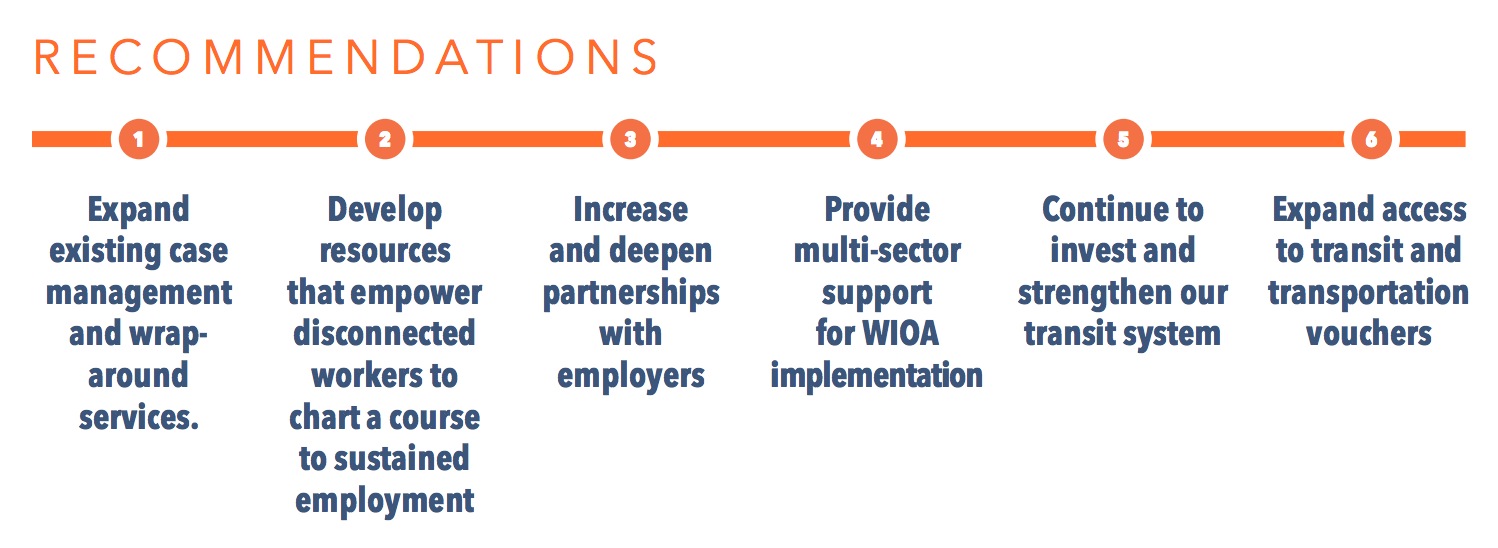CENTER FOR PLANNING EXCELLENCE
Introduction
In efforts to realize the opportunities associated with the recent spate of economic growth and to meet the needs of employers, a number of programs and incentives have been developed to strengthen Louisiana’s pipeline of skilled workers. The Baton Rouge Area Chamber’s recent report, Embracing Opportunity: An Analysis of Efforts to Meet Capital Region Workforce Demands, identifies training programs that are certifying workers for many of the most in-demand jobs in the Capital Region, and quantifies the need for expansion of some of these programs if we are to close the gap between our local supply of qualified workers and rapidly growing demand for skilled labor.
The purpose of CPEX’s report is to highlight the need for a similar expansion and enhancement of programs designed to help disconnected workers in the Capital Region who need assistance to become job-ready, access transportation that connects them to opportunities, and enter the workforce. Disconnected workers are those who are chronically under- or unemployed, often due to multiple barriers such as lack of education, health issues, homelessness, and financial and family instability, among others. Without more people moving into the entry-level sections of our workforce pipeline, efforts to expand training for skilled labor will eventually be constrained by a lack of workers who possess the basic levels of education required to begin additional training. Furthermore, the quality of life required to retain homegrown talent and attract new talent is compromised by widespread poverty and stark economic disparities. Without targeted efforts to re-engage disconnected workers into our economy, poverty will continue to grow, disparities will widen, and growth will stall.
According to CEOs for Cities and other leading regional economic development experts, “human capital is the single most important input for economic growth … to have an impact, however, it must be properly deployed into jobs.” The 2015 Manufacturing and Logistics Report Card produced by The Ball State University Center for Business and Economic Research cites human capital as “the most important factor in firm location decisions.” Unfortunately, this is the one category in which Louisiana earns an F. If we don’t connect those who need jobs to education, training and employment opportunities, our available human capital is being underutilized, too many families don’t have what they need to thrive, and the entire region misses out.
…
Transportation
Investing in adult education and services to prepare disconnected workers for job training is only one part of the equation. During interviews with more than a dozen organizations providing services in the Capital Region, transportation consistently emerged as a top challenge facing their clients.
Residents who don’t have access to an automobile are often stranded, and this applies disproportionately to disconnected workers in the Capital Region. According to 2010 data, Baton Rouge has a high percentage of households without vehicles – 11% compared to 9% nationwide. These residents, the majority of whom are low-income, have limited access to transit services that could connect them to the education, training and jobs they need to get ahead. Of regions nationwide, metro areas in the South have the lowest transit coverage rate for zero-vehicle households, resulting in limited mobility and restricted access to economic opportunity. Only 32.5% of jobs in Southern metros are available via a transit trip of 90 minutes or less.9 This figure doesn’t include training centers, nor does it account for jobs outside urban areas, such as the thousands of jobs becoming available in the river parishes along the I-10 corridor in South Louisiana, which are not served by fixed route transit.
Data does not currently exist to quantify the availability of transit to connect disconnected workers in the Capital Region to the various services and programs they need in order to progress towards employment. However, representatives of all the organizations interviewed explained that existing transit service does not meet the needs of many clients who lack access to a personal vehicle, either because the service is too infrequent, the travel times are too lengthy, or the routes don’t take them where they need to go. For persons with disabilities, it was reported that the lengthy paperwork and extensive documentation required to qualify for on-demand transit was a barrier to access, especially for those living in group facilities where administrative demands are high. Access to transit service even impacts funding for adult education because student attendance and accumulated hours play a large role in the amount of funding available. If students are struggling to get to class on a regular basis and exit exams are delayed, federal funding is reduced.
With the rapid expansion of industrial manufacturing and other key industries now underway, the need to improve connectivity between employers, training, services and the workforce is more pressing than ever. Prioritizing areas of greatest economic need for transit improvements and expansions is key to improving access to opportunity for disconnected workers. Further, a strong regional multi-modal transportation network doesn’t only serve to connect low-income workers to education and training — it is a key feature of a healthy regional economy that benefits all players. A variety of mobility options attracts young talent; enables employers to reach a broader labor pool; makes workforce housing more affordable; enables seniors to age-in-place and reduces congestion on our over-crowded roadways. Improvements in a multi-modal transportation network must occur simultaneously with expansions of other services that are key to developing our workforce and ensuring access to opportunity for both workers and employers.
Download full version (PDF): Entering the Pipeline
About the Center for Planning Excellence
www.cpex.org
CPEX is committed to the actions that will help communities and elected officials make informed, regionally-coordinated decisions about their future development.
Tags: Center for Planning Excellence, CPEX, Louisiana, New Orleans







 RSS Feed
RSS Feed